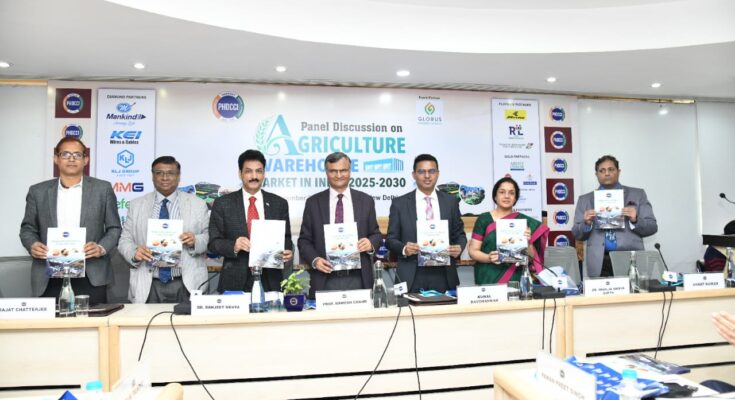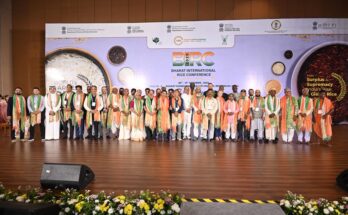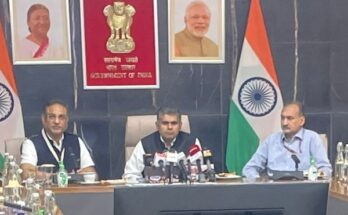By BK JHA
Amid India’s unprecedented agricultural surge—with the country emerging as the world’s second-largest producer of agri-commodities and foodgrain output hitting a historic 354 million tonnes in 2024–25—the nation faces a structural challenge that demands immediate attention: the widening gap between rising production and scientific storage capacity. By 2030–31, India’s foodgrain output is expected to approach 368 million tonnes, making modern warehousing indispensable for protecting national food security, reducing post-harvest losses, and ensuring stable farmer incomes.
Sounding an urgent call to action, Prof. Ramesh Chand, Member, NITI Aayog, said, “India today needs more warehouses than more production. Without scientific and scalable storage, even record harvests lose value. Warehousing is central to price stability, buffer stocking, and household food security. The time has come for a national investment movement in agricultural warehousing.”
Prof. Chand was speaking at the Panel Discussion on “Agriculture Warehouse Market in India 2025–2030,” organized by PHD Chamber of Commerce and Industry (PHDCCI) at PHD House, New Delhi.
Releasing the PHDCCI report, Prof. Chand praised its depth and relevance, noting that it “adds value to India’s ongoing policy dialogue on agriculture logistics.” He recommended the creation of a complementary analytical report on cold storage to complete the nation’s warehousing roadmap and urged PHDCCI to collaborate with NITI Aayog for a detailed workshop to take the sectoral recommendations forward.
The report highlights a projected 69 MMT scientific storage deficit by 2030, calling it one of India’s most pressing agri-infrastructure gaps. While schemes such as PEG, AIF, and PPP-driven silo projects have strengthened policy frameworks, challenges remain across contractual norms, land availability, financing mechanisms, and operational viability.
Setting the thematic tone, Dr. Shailja Vaidya Gupta, Former Senior Adviser in the Office of the Principal Scientific Adviser to the Government of India, emphasized the need for climate-adaptive silos as India faces increasingly erratic weather patterns.
“For India, buffer storage is a stronger long-term strategy than trade,” she said, calling for an expanded warehousing footprint, smoother regulations, and deeper private participation. She stressed that climate-resilient storage technologies will be essential to reduce grain deterioration and ensure year-round stability.
Industry leader Pawan Preet Singh underscored persistent pain points affecting sectoral growth—including high insurance premiums, rigid GST architecture, interest cost burdens, and payment challenges stemming from 174-MT stack size norms in PEG facilities. He reiterated the industry’s long-standing demand: granting priority-sector status to agri-warehousing, which would unlock affordable finance and stimulate large-scale private investment.
Kunal Bavdhankar cautioned against a one-size-fits-all approach and said, “India’s warehousing ecosystem must evolve with region-specific, capacity-specific and workforce-aligned technologies,” he said. He proposed decentralised food parks and integrated service-driven warehouses, which can significantly reduce logistics costs and unlock higher operational efficiency.
On digitization, Ajay Kakra called for an integrated public-private warehousing map, the adoption of end-to-end digital workflows, temporary storage solutions during peak harvest months, and stronger mechanisms to minimize losses at each node of the supply chain.
Panelist Rajat Chatterjee highlighted the potential of e-negotiable warehouse receipts, which are steadily increasing capital access for farmers and FPOs. However, he flagged obstacles such as low rural financial literacy, uneven geographic distribution, and climate risks, arguing for innovative blended finance models to de-risk investments.
According to the PHDCCI report, the foodgrain warehousing storage market is projected to grow from ₹37,336 crore in 2025-26 to ₹43,953 crore by 2030-31, driven by rising procurement needs, expanding PPP silo projects, and an active private warehousing industry. The next decade will witness major adoption of high-end technologies such as IoT-enabled climate monitoring, automated grain quality labs, blockchain-based traceability systems, and digital twins for predictive maintenance. These advancements will be critical to building a resilient, efficient agri-logistics backbone for India’s “Viksit Bharat @ 2047” vision.
Ranjeet Mehta, CEO and Secretary General, PHDCCI, said, “India is poised to become the food basket of the world. Warehousing and logistics are the silent engines of our agricultural transformation, and the government is actively enabling private investment to ensure that the backbone of our food economy is future-ready.”




